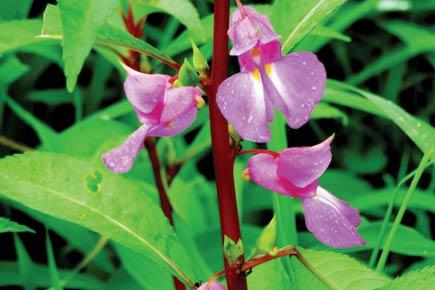As a wildlife biologist, I’ve always been inclined towards behaviour and evolutionary biology than genetics and molecular biology.

Anand Pendharkar
 As a wildlife biologist, I’ve always been inclined towards behaviour and evolutionary biology than genetics and molecular biology. However, the very first lessons of genetics way back in college days were intriguing and opened an amazing world for my curious mind. The Mendelian crosses, which we studied explained how hybrids were produced. And, the most popular plant studied during our laboratory practicals were red and white Balsams, which on hybridisation could produce red, white and pink coloured flowers in the next generation.
As a wildlife biologist, I’ve always been inclined towards behaviour and evolutionary biology than genetics and molecular biology. However, the very first lessons of genetics way back in college days were intriguing and opened an amazing world for my curious mind. The Mendelian crosses, which we studied explained how hybrids were produced. And, the most popular plant studied during our laboratory practicals were red and white Balsams, which on hybridisation could produce red, white and pink coloured flowers in the next generation.

A slice of the fungal diversity found in Mumbai
ADVERTISEMENT
But this wasn’t my first introduction to the Balsam flowers. Every evening, a flower vendor used to tuck a small leaf-covered packet of assorted flowers and leaves to be used by my mother during her prayers the next day. Balsams were the brightest members in this packet. I remember seeing their spurs, and later learnt that they contain deep nectaries, which caused butterflies to evolve equally long probosces. They were, unwittingly, picking up pollen grains to be transported to other flowers, resulting in cross-pollination. And back then, I never realised that such startling lessons in co-evolution existed in plain sight. But what really caught my fancy with relation to Balsams was the explosive dehiscence of their mature seed capsules, which burst on contact with humans, animals or even raindrops. This eagerness to catapult seeds to a far off location by spring-action led to its Latin name, Impatiens. This is another biology lesson worth experiencing — the property of plants to show reflexes or response to stimuli, a character that we usually designate to Kingdom Animalia.
Impatiens is a pan-tropical Genus with around 1,000 species distributed throughout the Northern Hemisphere, of which India has 55 species. All balsams prefer moist, rich soils and can be found in roadside ditches, reed beds, fences, river banks and forest edges from sea level to up to 2000m in the Himalaya. The vibrant white, pink, mauve and red flowers from annual or perennial species are selected depending on local climates and time available for gardening. Their nectaries attract many birds and insects, though the flowers lack fragrance.
All Impatiens are upright, soft-stemmed plants, growing 30-90cms and flowering profusely. Their alternately arranged, lustrous, water-repellent leaves are important food for many insect larvae, but have a bitter taste and slight toxicity. This is probably due to glycosides or alkaloids and calcium oxalate crystals, which upon ingestion by other animals, including humans, causes vomiting and diarrhoea. With this context, one may wonder why the flowers of dangerous Balsams are offered in religious ceremonies, such as in Ganesh Chaturthi. However, the paste of the Impatiens flower when applied externally relieves arthritic pain, soothes burns and is an effective remedy for anuria (less urination). Further on, our local Impatiens balsamina has anti-cancerous, anti-inflammatory and emetic (causing vomiting) properties, besides being and an effective laxative. Thus the origin of balsamico in Balsamic Vinegar, which actually means 'balsam-like' refers to Balsam's 'restorative' or 'curative' properties, though funnily Balsamic Vinegar contains no balsam.
To most Balsams mean colour and charm. However, to me, the Balsams will always remain the model organisms for observing evolutionary developmental biology.
Write in to Anand at sproutsenvttrust@gmail.com
 Subscribe today by clicking the link and stay updated with the latest news!" Click here!
Subscribe today by clicking the link and stay updated with the latest news!" Click here!







